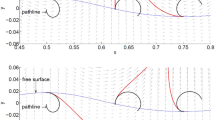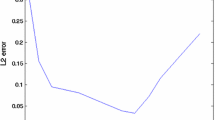Abstract
Numerically stable formulas are presented for the closed-form analytical solution of the X-IVAS scheme in 3D. This scheme is a state-of-the-art particle-based explicit exponential integrator developed for the particle finite element method. Algebraically, this scheme involves two steps: (1) the solution of tangent curves for piecewise linear vector fields defined on simplicial meshes and (2) the solution of line integrals of piecewise linear vector-valued functions along these tangent curves. Hence, the stable formulas presented here have general applicability, e.g. exact integration of trajectories in particle-based (Lagrangian-type) methods, flow visualization and computer graphics. The Newton form of the polynomial interpolation definition is used to express exponential functions of matrices which appear in the analytical solution of the X-IVAS scheme. The divided difference coefficients in these expressions are defined in a piecewise manner, i.e. in a prescribed neighbourhood of removable singularities their series approximations are computed. An optimal series approximation of divided differences is presented which plays a critical role in this methodology. At least ten significant decimal digits in the formula computations are guaranteed to be exact using double-precision floating-point arithmetic. The worst case scenarios occur in the neighbourhood of removable singularities found in fourth-order divided differences of the exponential function.
Similar content being viewed by others
Notes
As the algebra involved is overwhelming and error-prone, we have used the computer algebra system Maple to perform the simplifications and verifications. Thus, human intervention is dedicated to identify patterns and to discover abstract expressions such as \(x_\mathrm {p}\), \(x_\mathrm {t}\), \(x_\mathrm {q}\), etc.
In this form the difference of the independent variables appear symbolically as input to a function that could be evaluated to machine precision
References
Caliari M (2007) Accurate evaluation of divided differences for polynomial interpolation of exponential propagators. Computing 80(2):189–201. doi:10.1007/s00607-007-0227-1
Caliari M, Ostermann A, Rainer S (2013) Meshfree exponential integrators. SIAM J Sci Comput 35(1):A431–A452. doi:10.1137/100818236
Diachin DP, Herzog JA (1997) Analytic streamline calculations on linear tetrahedra. In: 13th computational fluid dynamics conference. American Institute of Aeronautics and Astronautics, Reston, pp. 733–742 doi:10.2514/6.1997-1975
Gilbert F, Backus GE (1966) Propagator matrices in elastic wave and vibration problems. Geophysics 31(2):326–332. doi:10.1190/1.1439771
Higham NJ (2002) Accuracy and stability of numerical algorithms. Soc for Ind Appl Math doi:10.1137/1.9780898718027
Higham NJ (2008) Functions of matrices: theory and computation. Society for Industrial and Applied Mathematics, Philadelphia
Hochbruck M, Lubich C, Selhofer H (1998) Exponential integrators for large systems of differential equations. SIAM J Sci Comput 19(5):1552–1574. doi:10.1137/S1064827595295337
Idelsohn SR, Marti J, Becker P, Oñate E (2014) Analysis of multifluid flows with large time steps using the particle finite element method. Int J Numer Methods Fluids 75(9):621–644. doi:10.1002/fld.3908
Idelsohn SR, Nigro N, Limache A, Oñate E (2012) Large time-step explicit integration method for solving problems with dominant convection. Comput Methods Appl Mech Eng 217–220, 168–185. doi:10.1016/j.cma.2011.12.008
Idelsohn SR, Oñate E, Del Pin F (2004) The particle finite element method: a powerful tool to solve incompressible flows with free-surfaces and breaking waves. Int J Numer Methods Eng 61(7):964–989. doi:10.1002/nme.1096
Kahan W, Darcy JD (1998) How java’s floating-point hurts everyone everywhere. ACM 1998 workshop on java for high-performance network computing. http://www.cs.berkeley.edu/~wkahan/JAVAhurt.pdf. Online; Accessed Feb 5 2014
Kipfer P, Reck F, Greiner G (2003) Local exact particle tracing on unstructured grids. Comput Graphics Forum 22(2):133–142. doi:10.1111/1467-8659.00655
McCurdy AC, Ng KC, Parlett BN (1984) Accurate computation of divided differences of the exponential function. Math Comput 43(168), 501–501. doi:10.1090/S0025-5718-1984-0758198-0
Nielson GM, Jung IH (1999) Tools for computing tangent curves for linearly varying vector fields over tetrahedral domains. IEEE Trans Vis Comput Graphics 5(4), 360–372. doi:10.1109/2945.817352
Oñate E, Idelsohn SR, Del Pin F, Aubry R (2004) The particle finite element method. An overview. Int J Comput Methods 1(2), 267–307. doi:10.1142/S0219876204000204
OpenCFD Ltd (ESI group): OpenFOAM–The open source CFD toolbox. http://www.openfoam.org/
Ostermann A, Thalhammer M, Wright WM (2006) A class of explicit exponential general linear methods. BIT Numer Math 46(2):409–431. doi:10.1007/s10543-006-0054-3
Parlett BN (1976) A recurrence among the elements of functions of triangular matrices. Linear Algebr Appl 14(2):117–121. doi:10.1016/0024-3795(76)90018-5
Price JF (2006) Lagrangian and Eulerian representations of fluid flow: kinematics and the equations of motion. Woods Hole Oceanographic Institution. http://www.whoi.edu/science/PO/people/jprice/class/ELreps.pdf. Online; Accessed Dec 10 2012
Weisstein EW (2013) Cubic formula. From MathWorld–a Wolfram web resource. http://mathworld.wolfram.com/CubicFormula.html. Online; Accessed Oct 23 2013
Acknowledgments
I thank Mr. Guillermo Casas-González (ORCiD: 0000-0002-1859-720X) for reading the manuscript in draft form and suggesting improvements. This study was partially supported by the SAFECON project of the European Research Council (European Commission) and the WAM-V project funded under the Navy Grant N62909-12-1-7101 issued by Office of Naval Research Global. The United States Government has a royalty-free license throughout the world in all copyrightable material contained herein.
Author information
Authors and Affiliations
Corresponding author
Additional information
Dedicated to Prof. Eugenio Oñate on the occasion of his 62nd birthday.
Rights and permissions
About this article
Cite this article
Nadukandi, P. Numerically stable formulas for a particle-based explicit exponential integrator. Comput Mech 55, 903–920 (2015). https://doi.org/10.1007/s00466-015-1142-5
Received:
Accepted:
Published:
Issue Date:
DOI: https://doi.org/10.1007/s00466-015-1142-5
Keywords
- X-IVAS scheme
- Particle finite element method
- Explicit exponential integrators
- Tangent curves
- Closed-form analytical solutions
- Finite arithmetic
- Loss of significance
- Numerically stable formulas




